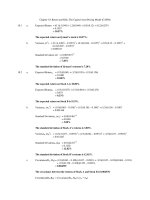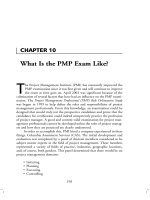Chapter 10 doc
Bạn đang xem bản rút gọn của tài liệu. Xem và tải ngay bản đầy đủ của tài liệu tại đây (319.04 KB, 41 trang )
© 2008 Pearson Prentice Hall, Electronic Commerce 2008, Efraim Turban, et al.
Chapter 10
Dynamic Trading: E-Auctions,
Bartering, and Negotiations
10-2
Learning Objectives
1. Define the various types of e-auctions and
list their characteristics.
2. Describe forward and reverse auctions.
3. Describe the benefits and limitations of e-
auctions.
4. Describe some unique e-auction models.
5. Describe the various services that support e-
auctions.
10-3
Learning Objectives
6. Describe bartering and negotiating.
7. Describe the hazards of e-auction fraud and discuss
possible countermeasures.
8. Describe e-auction deployment and implementation
issues.
9. Analyze mobile and future directions of e-auctions.
10-4
Fundamentals of
Dynamic Pricing and E-Auctions
auction
Market mechanism by which buyers make bids and
sellers place offers; characterized by the competitive
and dynamic nature by which the final price is reached
electronic auctions (e-auctions)
Auctions conducted online
10-5
Fundamentals of
Dynamic Pricing and E-Auctions
dynamic pricing
Fluctuating prices that are determined based on
supply and demand relationships at any given time
10-6
Fundamentals of
Dynamic Pricing and E-Auctions
10-7
Fundamentals of
Dynamic Pricing and E-Auctions
One Buyer, One Seller
One Seller, Many Potential Buyers
forward auction
An auction in which a seller offers a product to
many potential buyers
sealed-bid auction
Auction in which each bidder bids only once; a
silent auction, in which bidders do not know who is
placing bids or what the bid prices are
Vickrey auction
Auction in which the highest bidder wins but pays
only the second highest bid
10-8
Fundamentals of
Dynamic Pricing and E-Auctions
One Buyer, Many Potential Sellers
reverse auction
Auction in which the buyer places an item
for bid (tender) on a request for quote (RFQ)
system; potential suppliers bid on the job,
with bid price reducing sequentially, and the
lowest bid wins; used mainly in B2B and
G2B e-commerce
10-9
Fundamentals of
Dynamic Pricing and E-Auctions
B2B reverse auctions
C2C reverse auctions
“name-your-own-price” model
Auction model in which would-be buyers
specify the price (and other terms) they are
willing to pay to any willing seller; a C2B
model pioneered by Priceline.com
10-10
Fundamentals of
Dynamic Pricing and E-Auctions
Many Sellers, Many Buyers
vertical auction
Auction that takes place between sellers
and buyers in one industry or for one
commodity
auction vortals
Another name for a vertical auction vertical
portal
10-11
Benefits, Limitations,
and Strategic Uses of E-Auctions
Benefits of E-Auctions
Benefits to sellers
Larger reach and increased revenues
Optimal price setting
Removal of expensive intermediaries
Liquidation
Lower transaction costs
Lower administrative costs
Better customer relationships
10-12
Benefits, Limitations,
and Strategic Uses of E-Auctions
Benefits to buyers
Opportunities to Find Unique Items and Collectibles
Lower prices
Anonymity
Convenience
Entertainment
Benefits to E-Auctioneers
Higher repeat purchases
A stickier Web site
Expansion of the auction business
10-13
Benefits, Limitations,
and Strategic Uses of E-Auctions
Limitations of E-Auctions
Possibility of fraud
Limited participation
Security
Auction software
Long cycle time
Monitoring time
Equipment for buyers
Order fulfillment costs
10-14
Benefits, Limitations,
and Strategic Uses of E-Auctions
Strategic Uses of Auctions and Pricing
Mechanisms
Through dynamic pricing, buyers and sellers
are able to adjust pricing strategies and
optimize product inventory levels very
quickly
Auctions for Publicity
Auctions can be used to attract attention
10-15
The “Name-Your-Own-Price” C2B Model
One of the most interesting e-commerce
models is the “name-your-own-price” model
This model enables consumers to achieve
significant savings by naming their own price
for goods and services
The concept is that of a C2B reverse auction,
in which vendors bid on a job by submitting
offers and the lowest-priced vendor or the one
that meets the buyer’s requirements gets the
job
10-16
The Forward E-Auction Process
and Software Support
10-17
The Forward E-Auction Process
and Software Support
Phase 1: Searching and Comparing
Auction aggregators and notification
auction aggregators
Companies that use software agents to visit
Web auction sites, find information, summarize
it, and deliver it to users
Browsing site categories
Basic and advanced searching
10-18
The Forward E-Auction Process
and Software Support
Phase 2: Getting Started at an Auction
Registration and participants’ profiles
Listing and promoting
Pricing
10-19
The Forward E-Auction Process
and Software Support
Phase 3: Bidding
Bid Watching and Multiple Bids
sniping
Entering a bid during the very last seconds of an
auction and outbidding the highest bidder
proxy bidding
Use of a software system to place bids on behalf
of buyers; when another bidder places a bid, the
software (the proxy) will automatically raise the
bid to the next level until it reaches the buyer’s
predetermined maximum price
10-20
The Forward E-Auction Process
and Software Support
Phase 4: Postauction Follow-Up
Postauction activities
Bidding notifications
End-of-auction notices
Seller notices
Postcards and thank-you notes
User communication
Chat groups
Mailing lists
Message boards
10-21
The Forward E-Auction Process
and Software Support
Feedback and ratings
Invoicing and billing
Payment methods
P2P transfer service
Escrow service
Credit card payment
Shipping and postage
10-22
The Forward E-Auction Process
and Software Support
Additional Terms and Rules
Bid retraction
Featured auctions
Other services
10-23
Double Auctions,
Bundle Trading, and Pricing Issues
Double Auctions
single auction
Auction in which at least one side of the market
consists of a single entity (a single buyer or a single
seller)
double auction
Auction in which multiple buyers and sellers may be
making bids and offers simultaneously; buyers and
their bidding prices and sellers and their asking
prices are matched, considering the quantities on
both sides
10-24
Double Auctions,
Bundle Trading, and Pricing Issues
bundle trading
The selling of several related products and/or services
together
Prices in Auctions: Higher or Lower?
Pricing strategies in online auctions
10-25
Bartering and Negotiating Online
bartering
The exchange of goods and services
electronic bartering (e-bartering)
Bartering conducted online, usually by a bartering
exchange
Consumer-to-consumer barter exchanges









